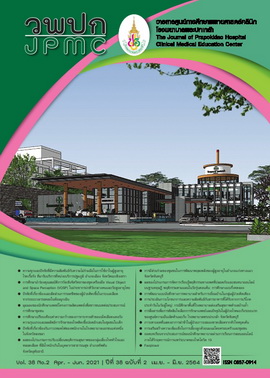The Association of Length of Stay in The Emergency Department and Survival Proportion among Sepsis Patients
Main Article Content
Abstract
BACKGROUND: Patients with sepsis (bloodstream infections) are semi-critically ill patients, and without timely treatment their mortality rate will rise. One of the many factors that impede prompt treatment is the length of the waiting time in the emergency room. It is important to study whether the waiting period in the emergency room will affect the survival rate of patients with sepsis.
OBJECTIVES: To find the relationship between length of stay in the emergency department and the survival proportion among sepsis patients and other associated factors.
METHODS: This study is a retrospective cohort study which was from collected data among 318 patients with sepsis. By comparing the survival proportions of patients with sepsis with a waiting period in the emergency room of not more than 24 hours and more than 24 hours but not more than 72 hours when they returned home 30 days after admission, the data were analyzed statistically to determine the relationship.
RESULTS: The waiting times in the emergency room (24 hours, more than 24 hours but not more than 72 hours, when discharged 30 days after admission) did not affect the survival rate of the infected patients (p = 0.41, 0.72, 0.25 and 0.11). In addition, it was found that the multiple organ dysfunction or failure (p < 0.001: Adjusted OR = 9.987: 95%CI 2.97 - 33.55) and low blood pressure caused by sepsis (p = 0.02: Adjusted OR = 4.1: 95%CI 1.24 - 13.54) were significantly related to the survival proportion.
CONCLUSIONS: The waiting time in the emergency room did not affect the survival proportion of patients with sepsis. Factors to be considered for this group of patients because they affect the survival rate of patients with sepsis were the blood pressure and multi-system failure, which can both be used to predict the survival rate of patients with sepsis.
Article Details
References
Chaou CH, Chiu TF, Yen AM, Ng CJ, Chen HH. Analyzing factors affecting emergency department length of stay-using a competing risk-accelerated failure time model. Medicine (Baltimore) [Internet].2016 [cited 2018 Feb 19];95(14):e3263. Available form: https://www.ncbi.nlm.nih.gov/pmc/articles/PMC4998795/pdf/medi-95-e3263.pdf
García-Gigorro R, de la Cruz Vigo F, Andrés-Esteban EM, Chacón-Alves S, Morales Varas G, Sánchez-Izquierdo JA, et al. Impact on patient outcome of emergency department length of stay prior to ICU admission. Med Intensiva 2017;41:201-8.
Bashkin O, Caspi S, Haligoa R, Mizrahi S, Stalnikowicz R. Organizational factors affecting length of stay in the emergency department: initial observational study. Isr J Health Policy Res [Internet]. 2015[cited 2018 Feb 19]; 4:38. Available form: https://www.ncbi.nlm.nih.gov/pmc/articles/PMC4606993/pdf/13584_2015_Article_35.pdf
Kang CI, Song JH, Chung DR, Peck KR, Ko KS, Yeom JS, et al. Risk factors and pathogenic significance of severe sepsis and septic shock in 2286 patients with gram- negative bacteremia. J Infect 2011;62:26-33.
Singer M, Deutschman CS, Seymour CW, Shankar-Hari M, Annane D, Bauer M, et al. The third international consensus definitions for sepsis and septic shock (Sepsis-3). JAMA 2016;315:801-10.
Tusgul S, Carron PN, Yersin B, Calandra T, Dami F. Low sensitivity of qSOFA, SIRS criteria and sepsis definition to identify infected patients at risk of complication in the prehospital setting and at the emergency department triage. Scand J Trauma Resusc Emerg Med [Internet]. 2017[cited 2018 Mar 14] 3;25(1):108. Available form: https://www.ncbi.nlm.nih.gov/pmc/articles/PMC5670696/pdf/13049_2017_Article_449.pdf
McLymont N, Glover GW. Scoring systems for the characterization of sepsis and associated outcomes. Ann Transl Med [Internet]. 2016[cited 2018 Mar 12];4(24):527. Available form: http://atm.amegroups.com/article/view/13068/13500
Karaca Z, Wong HS, Mutter RL. Duration of patients' visits to the hospital emergency department. BMC Emerg Med [Internet]. 2012[cited 2018 Feb 19];12:15. Available form: https://bmcemergmed.biomedcentral.com/articles/10.1186/1471-227X-12-15
Blauvelt A, Cohen AD, Puig L, Vender R, van der Walt J, Wu JJ. Biosimilars for psoriasis: preclinical analytical assessment to determine similarity. Br J Dermatol 2016;174:282-6.
Band RA, Gaieski DF, Hylton JH, Shofer FS, Goyal M, Meisel ZF. Arriving by emergency medical services improves time to treatment endpoints for patients with severe sepsis or septic shock. Acad Emerg Med 2011;18:934-40.
Vermeulen MJ, Guttmann A, Stukel TA, Kachra A, Sivilotti ML, Rowe BH, et al. Are reductions in emergency department length of stay associated with improvements in quality of care? A difference-in-differences analysis. BMJ Qual Saf 2016;25:489-98.
Young MP, Gooder VJ, McBride K, James B, Fisher ES. Inpatient transfers to the intensive care unit:delays are associated with increased mortality and morbidity. J Gen Intern Med 2003;18:77-83.
Yoon P, Steiner I, Reinhardt G. Analysis of factors influencing length of stay in the emergency department. CJEM 2003;5:155-61.
Chaou CH, Chen HH, Chang SH, Tang P, Pan SL, Yen AM, et al. Predicting length of stay among patients discharged from the emergency department-using an accelerated failure time model. PLoS One [Internet]. 2017[cited 2018 Feb 19];12(1):e0165756. Available form: https://journals.plos.org/plosone/article?id=10.1371/journal.pone.0165756
Angus DC, van der Poll T. Severe sepsis and septic shock. N Engl J Med 2013; 369(9):840-51.
